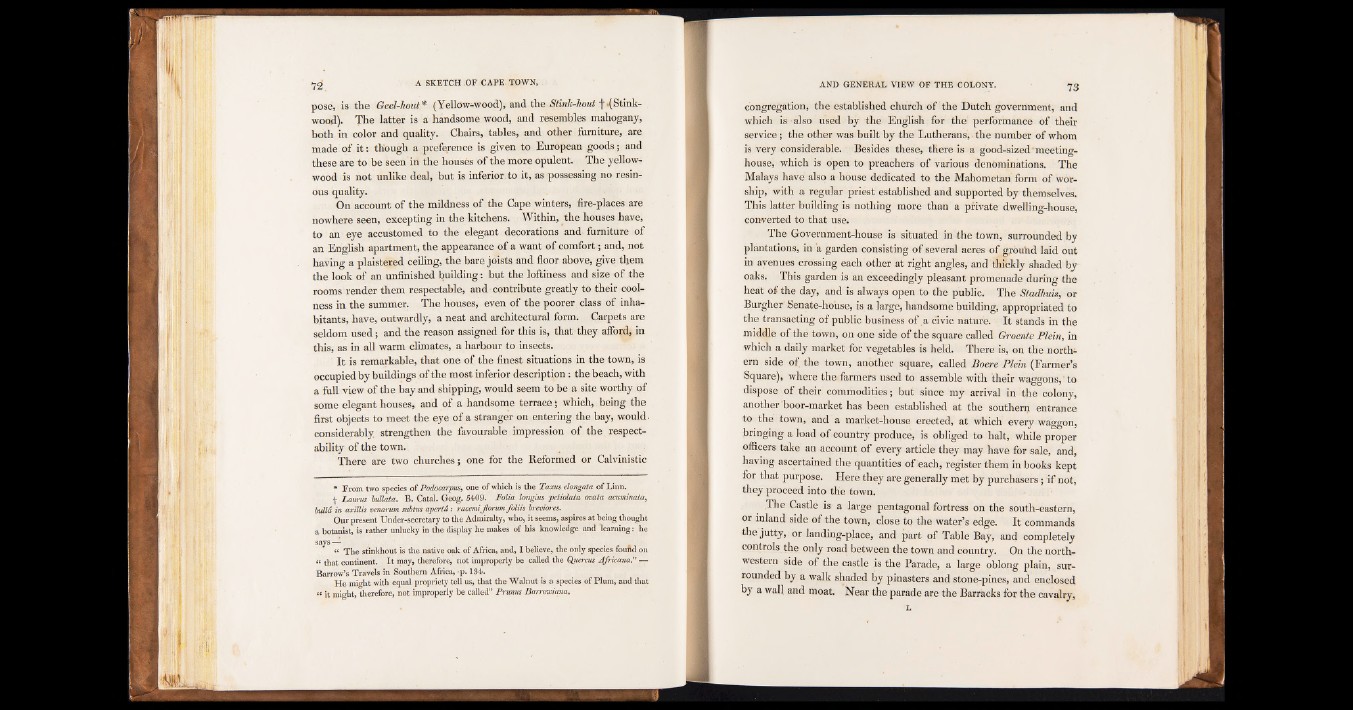
pose, is the Geel-hout* (Yellow-wood), and the Stink-hout f .(Stink-
wood). The latter is a handsome wood, and resembles mahogany,
both in color and quality. Chairs, tables, and other furniture, are
made of it: though a preference is given to European goods; and
these are to be seen in the houses of the more opulent. The yellow-
wood is not unlike deal, but is inferior to it, as possessing no resinous
quality.
On account of the mildness of the Cape winters, fire-places are
nowhere seen, excepting in the kitchens. Within, the houses have,
to an eye accustomed to the elegant decorations and furniture of
an English apartment, the appearance of a want of comfort; and, not
having a plaistered ceiling, the bare joists and floor above, give them
the look of an unfinished building: but the loftiness and size of the
rooms render them respectable, and contribute greatly to their coolness
in the summer. The houses, even of the poorer class of inhabitants,
have, outwardly, a neat and architectural form. Carpets are
seldom used; and the reason assigned for this is, that they afford, in
this, as in all warm climates, a harhour to insects.
It is remarkable, that one of the finest situations in the town, is
occupied by buildings of the most inferior description: the beach, with
a full view of the bay and shipping, would seem to be a site worthy of
some elegant houses, and of a handsome terrace; which, being the
first objects to meet the eye of a stranger on entering the bay, would-
considerably, strengthen the favourable impression of the respectability
of the town.
There are two churches; one for the Reformed or Calvinistic
* From two species of Podocarpm, one of which is the Taxus elongata of Linn,
j. Laurus bullata. B. Catal. Geog. 54-09. Folia longius petiolata ovata acuminata,
build in axillis venarum subtus apertd: racemijlorumjbliis brevtores.
Our present Under-secretary to the Admiralty, who, it seems, aspires at being thought
a botanist, is lather unlucky in the display he makes of his knowledge and learning: he
says — . ■
it The stinkhout is the native oak of Africa, and, I believe, the only species found on
“ that continent. I t may, therefore, not improperly be called the Qjiercus AJricanaP •—
Barrow’s Travels in Southern Africa, -p. 184.
He might with equal propriety tell us, that the W alnut is a species of Plum, and that
“ it might, therefore, not improperly be called” Prunus Batrowana.
congregation, the established church of the Dutch government, and
which is also used by the English for the performance of their
service; the other was built by the Lutherans; - the number of whom
is very considerable. Besides these, there is a good-sized meetinghouse,
which is open to preachers of various denominations. The
Malays have also a house dedicated to the Mahometan form of worship,
with a regular priest established and supported by themselves.
This latter building is nothing more than a private dwelling-house,
converted to that use.
The Government-house is situated in the town, surrounded by
plantations, in a garden consisting of several acres of gyou'nd laid out
in avenues crossing each other at right angles, and thickly shaded by
oaks. This garden is an exceedingly pleasant promenade during the
heat of the day, and is always open to the public. The Sladhuis, or
Burgher' Senate-house, is a large, handsome building, appropriated to
the transacting of public business of a civic nature. It stands in the
middle of the town, on one side of the square called Groente Plein, in
which a daily market for vegetables is held. There is, on the northern
side of the town, another square, called Boere Plein (Farmer’s
Square), where the farmers used to assemble with their waggons,'to
dispose of their commodities; but since my arrival in the colony,
another boor-market has been established at the southern entrance
to the town, and a market-house erected, at which every waggon,
bringing a load of country produce, is obliged to halt, while proper
officers take an account of every article they may have for sale, and,
having ascertained the quantities of each, register them in books kept
for that purpose. Here they are generally met by purchasers; if not,
they proceed into the town.
The Castle is a large pentagonal fortress on the south-eastern,
or inland side of the town, close to the water’s edge. It commands
the jutty,: or landing-place, and part of Table Bay, and completely
controls the only road between the town and country. On the northwestern
side of the castle is the Parade, a large oblong plain, surrounded
by a walk shaded by pinasters and stone-pines, and enclosed
by a wall and moat. Near the parade are the Barracks for the cavalry,
L